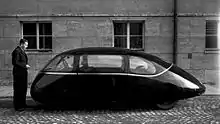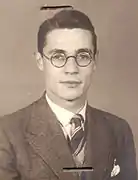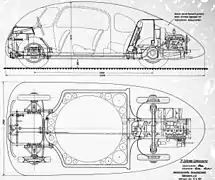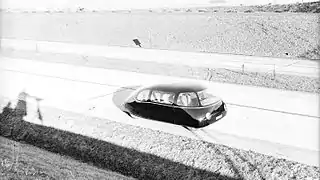Schlörwagen
The Schlörwagen (nicknamed "Göttinger Egg" or "Pillbug")[1] was a prototype aerodynamic rear-engine passenger vehicle developed by Karl Schlör (1911–1997) and presented to the public at the 1939 Berlin Auto Show. It never went into production, and the sole prototype has not survived.


Design history
Schlör, an engineer for Krauss Maffei of Munich, proposed an ultra-low drag coefficient body as early as 1936.[2] Under Schlör's supervision at the AVA (an Aerodynamic testing institute in Göttingen) a model was built.[3] Subsequent wind tunnel tests yielded an extraordinarily low[3] drag coefficient of 0.113.[1] For a functioning model, a Mercedes-Benz 170H chassis,[1] one of their few rear-engine designs, was used. The aluminum body was built by the Ludewig Brothers of Essen. Subsequent tests of the motorized model showed a slightly higher but still impressive drag coefficient of 0.186.[2]
The Schlörwagen was built on a modified chassis of the Mercedes 170 H. The wheelbase was 2.60 meters, the vehicle was 4.33 meters long and 1.48 meters high. The width of 2.10 meters was needed to run the wheels inside the body. The bodywork made by an Essen-based company was teardrop-shaped, had flush-fitting windows with curved windows and a closed floor. However, despite the construction of aluminum, it was about 250 kg heavier than that of the Mercedes 170H; its aerodynamic shape and because of the rear engine far back center of gravity affected the driving safety of the Schlörwagens and made them very vulnerable to crosswinds.
In a test drive with a production vehicle Mercedes 170H as a comparison, the Schlörwagen tested about 135 km/h top speed - 20 km / h faster than the Mercedes; and consumed 8 liters of fuel per 100 kilometers - 20 and 40 percent less fuel than the reference vehicle. According to Karl Schlör, the vehicle could reach a speed of 146 km/h.
A year later it was unveiled to the public at the 1939 Berlin Auto Show.[1][2] Despite generating much publicity, it was perceived by the public as ugly.[4]The project was shelved with the onset of World War II and mass production was never realized.[2]
Later history
In 1942, the prototype was fitted with a captured Soviet airplane engine, and driven around a test track.[5][3]
The prototype appears to have been stored until August 1948 on the site of the German Aerospace Center (DLR) in Göttingen. Schlör's attempts to obtain the heavily damaged body from the British military administration failed, and its fate is unknown.[1]
In 2007 the German Aerospace Center (DLR), re-tested a small original model in a wind tunnel: It showed no stalls or braking turbulence. One of the original drawings kept in the DLR archives in the scale 1:5 is on display in the PS Speicher transport museum in Einbeck.[4][6]
Gallery
See also
References
- Christopher, John (2013). The Race for Hitler's X-Planes. The Mill, Gloucestershire: History Press. p. 200. ISBN 978-0-7524-7711-4. Retrieved 2014-06-11.
- "Lord K" (November 18, 2011). "Lord K's Garage #113: The Schlörwagen". Archived from the original on May 29, 2013.
- "170V und 170H einmal ganz anders !". MB-EXOTENFORUM - Sonderkarossen/Umbauten/Tuning (in German). Archived from the original on February 1, 2014.
- "Forscher lösen Rätsel des "Flügels auf Rädern"" (PDF). DLR. Retrieved 14 March 2020.
- Branch, Jon C. "THE SCHLÖRWAGEN: THE AUTOBAHN CRUISER THAT WASN'T". revivaler.com. Retrieved 14 March 2020.
- ps-speicher.de





